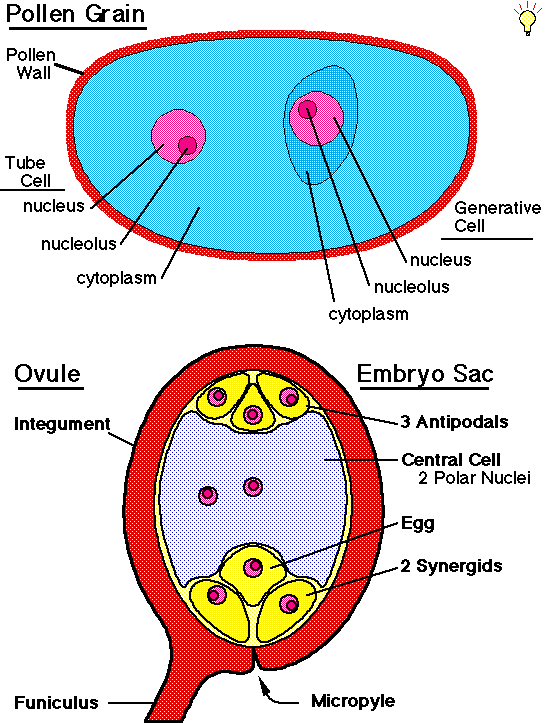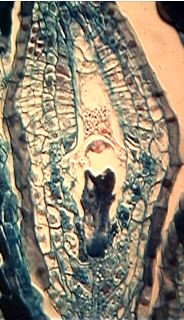Now that you know something about the flower and its parts, it is time to dig into some of the"business" end of what a flower does.
As you know, the anther of the stamen produces pollen grains. That in itself is an interesting process that I would discuss in detail with a course for biology majors. For this course, I'll leave it that indeed the anther makes pollen grains.
What is a pollen grain? This structure is almost dust-sized. It has an outer wall that, in some wind-pollinated species, is allergenic to humans. In the photomicrograph below, the thick wall appears somewhat reddish due to a dye used in the preparation of the microscope slide.

Inside the pollen wall are two cells. The cell with lots of bluish cytoplasm (filling up the inside of the pollen wall) is the tube cell. The smaller cell (on top of the tube cell) is the generative cell. Notice that both cells have a lavender nucleus and each nucleus has a red nucleolus. The nuclei of the two cells are the same size...the cells differ in the amount of cytoplasm present. The tube cell has much cytoplasm, the generative cell has far less.
The tube cell grows to penetrate the pollen wall and then the stigma and style tissues of the carpel. This penetrating cell is now called the pollen tube. Its growth is chemotropic (grows toward a source of chemicals)...likely toward calcium, boron, and/or auxin. The chemical source is an ovule. The pollen tube's chemotropism results in the tube arriving in a small opening in the ovule's integument...the micropyle (see below).
Here is a labeled diagram of both the pollen grain and the ovule:

The pollen tube arrives in the micropyle of the integument of the ovule, and enters the embryo sac.
The synergids of the embryo sac literally put their energies together to burst the end of the pollen tube. Meanwhile, the generative cell has followed the pathway digested by the tube cell. Along the way it has divided to produce two sperm cells. The two sperm cells exit the pollen tube through the burst end.
One sperm cell unites with the egg. This process is called syngamy (union of gametes) or [gag] fertilization. I much prefer syngamy to fertilization (see below). The product of the union of egg and sperm is called a zygote, and it has two sets of master plans, one from each gamete. The zygote will divide and grow and differentiate to become a new embryonic plant with root, stem, and leaf. Ultimately it will become an adult plant.
The other sperm cell unites with the central cell. This is a second syngamy! It is a three-way fusion between the two polar nuclei of the central cell and the sperm cell. The resulting endosperm cell has three sets of master plans (one from sperm and one each from the two polar nuclei). The endosperm cell divides to form a nutritive tissue inside the seed. It accumulates nutrients from the mother plant and stores them away for the developing embryo inside the seed. The nutrients are stored as starch, protein, and/or oil. Initially the endosperm is liquid (the famous endosperm at this stage is cocoanut milk). Later the endosperm becomes cellular and solid (grated cocoanut"meat" is really endosperm). Solid endosperm of grain crops (wheat, barley, oats) is ground up to make flour (toast, cookies,"cereal") or cooked to make rice and so on. Endosperm is a very important food source for humans! Next time you slurp down a piña colada, think about drinking liquid endosperm!
Here is a view of an ovule. The antipodals are not well shown, but disintegrate anyway. The central cell is larger than the lower egg cell. The synergids are quite dark and elongate in this view:

Ultimately, changes in the ovule result in further change. The egg becomes a zygote becomes an embryo with many parts. The endosperm gains nutrients and becomes solid nutrition for the embryo. The antipodals and synergids disintegrate. The integument becomes a seed coat. The ovule complete becomes a seed with the three important constituents: seed coat, storage tissue, and dormant embryo. The ovule continues to make hormones to cause the ovary wall to become a fruit. That is a subject for another time.
This is an"aside" and represents a personal opinion along with some history of biology. The terminology we use comes with historical baggage. Fertilization is one such term.
Prior to 1800 the world was an agrarian system...everyone was a farmer (with very rare exceptions). Farmers knew for millenia that seeds were planted in a field and grew into plants. Of course fertilizer (manure, compost, dead fish, etc.) was known to make a field more fertile (able to grow plants).
People observed their farm animals mating and producing offspring. The connection between the two behaviors was fairly easy to see as the gestations were shorter and matings were controlled by fencing and so on. The human situation was less obvious but likely parallel.
Males know about ejaculation as it is an external phenomenon and men know when it happens. The connection between ejaculation, intercourse, and pregnancy was fairly obvious. Being farmers, the men thought of ejaculation during intercourse as"planting the seed" in a female. Other than being a"fertile field," females were thought not to contribute to the"seed" itself. The term sperm for this male contribution was chosen as it means seed.
Indeed, when Leeuwenhoek first observed swimming sperm cells in his microscope (late 1600s) it was a landmark finding. An ejaculation produces astronomical numbers of sperm cells...they are easy to find. The cells were also named sperm (which means seed). Early sketches of the sperm cells even showed a tiny human body with eyes and appendages compressed within the"head" of the sperm. The tiny human seed was even referred to as the homunculus (literally the tiny human). The microscopes were not too good in those days...obviously. It also shows how data and interpretation are influenced by"what you expect to see."
Such agrarian ideas of human seeds and fertile fields resulted in the idea embodied in the word fertilization. The dominant male planted the seeds, making the submissive female fertile. The seed grew up into a new baby human. The human culture of the day fostered such erroneous interpretations.
It was not until much later that mammalian eggs were even found. In humans the two ovaries produce only one egg between them during a few-day period in each month. The egg is produced in fluid-filled tubular anatomy of vast volumes (compared to the egg itself). Finding this one cell in such a huge amount of anatomy was only accomplished recently (in terms of human history). Thus physical evidence of female contributions to reproduction (other than fertile fields) was only recent. We now know that both male and female make equal genetic contributions to the offspring.
I like the term syngamy, rather than fertilization, because syn- implies some union or joining of forces and -gamy refers to gametes. The egg and sperm are gametes...neither is a seed...and both are needed for successful sexual reproduction. Males and females are fertile whether they have intercourse or not. Neither makes the other fertile! Moreover, there is no manure or 'miracle grow' to be needed or used in sexual reproduction, so fertilization is just inappropriate. Sure it has the precedent of history, but it is a word I'd like to eliminate because of the inaccurate picture painted by that word.
You don't have to agree with me on this, but do give it some thought and try to use syngamy rather than fertilization within my earshot. Thanks!
This page © Ross E. Koning 1994.
The MLA citation style for this page would be:
Koning, Ross E."Pollen and Embryo Sac". Plant Physiology Website. 1994. http://koning.ecsu.ctstateu.edu/plants_human/pollenemb.html (your visit date).
Go back to the Course Schedule.
Go back to Ross Koning's Home Page.
Send comments and bug reports to Ross Koning at koning@ecsu.ctstateu.edu.
View the Standard Disclaimer.